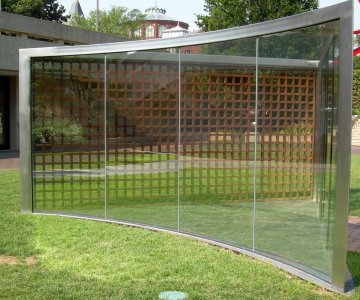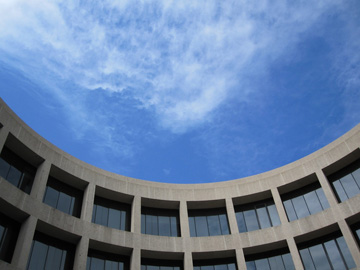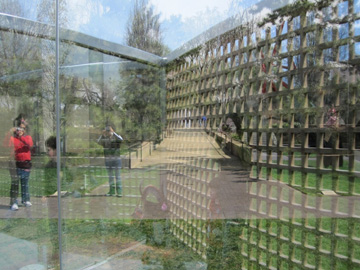
Dan Graham, "For Gordon Bunshaft," 2008. Two-way mirror, steel, wood. Courtesy the Hirshhorn Museum and Sculpture Garden, Washington, D.C.
One of my ongoing curatorial interests has been the relationship between perception and subject formation — how does what we perceive say about who we are, and vice versa? How do we act on this information? What is an artist’s role in making us aware of this process? How does an artwork’s site or location contribute to our perception and understanding?
These questions came to mind on a recent trip to the Hirshhorn Museum in DC (I’ll review the ColorForms exhibition in an upcoming post), where I saw Dan Graham’s For Gordon Bunshaft (2008) commissioned for the sculpture garden opposite the museum. One of the artist’s signature “pavilions,” it honors Hirshhorn architect Gordon Bunshaft (1909-1990), whose other notable achievements include Yale’s Bienecke Rare Book and Manuscript Library (1963).
Graham’s sculpture references Bunshaft’s brutalist structure specifically, as well as modernism and architecture in general, in several ways. The wooden lattice wall corresponds to the Hirshhorn’s interior courtyard windows (above); to the modernist grid employed by Sol Lewitt and other Minimalists; and to Japanese architecture. The two-way mirror glass and steel frame comprising the other sides of the triangle are materials of corporate architecture which, Graham has noted, are often used “to control a person or group’s social reality” in public spaces like airports or hospitals. (The sliding glass door does have the heft and feel of walking into a lobby.) Other references are more subtle — through a podcast talk with Hirshhorn curatorial assistant Al Miner, I learned that the common slate floor inside alludes to the backyard patios that were ubiquitous in suburban New Jersey, where Graham was raised. I didn’t notice this material on my visit, but it closes the loop on the play of opposites common to much of Graham’s work – urban/suburban, corporate/domestic, interior/exterior.
The tension between individual/collective is another key element, and there were quite a few people around during my visit, allowing for the social interaction Graham intends with his pavilions. As I both observed and participated in the action around the sculpture, I wondered, is there a social protocol for art installations? Do you wait to enter until the piece is empty, like an ATM or phone booth? Or do you go ahead and confine yourself to a close space with a bunch of strangers? Each scenario provides a different experience. We all crowded in. Inside, you remain part of, yet simultaneously separate from the environment. Depending on the light and your vantage point, you either see yourself, others in the pavilion, or the garden and other sculptures outside.
I can no longer remember where I was in relation to the work when I took the above photo – inside or out? These reflections and refractions make visible the sense of dislocation the pavilion generates. “The viewer’s consciousness as a subject,” Graham writes in Two-Way Mirror Power, is both a product of the work and a work itself, a “secondary, veiled object.” Both James Turrell and Olafur Eliasson have created environments to encourage this phenomenon — “seeing ourselves seeing,” or the awareness of our own presence and cognition. Rather than the meditative experience Turrell’s work manifests, or the predominately social and grand scale of Eliasson’s installations, however, Graham’s space provokes a kind of funhouse anxiety, both voyeuristic and narcissistic. What we sense, the information that we consciously register, points to not only where we stand but who we are. Where was I?
Over the next two weeks, I look forward to sharing more thoughts on perception, site and community dialogue, as well as contemporary art practices that defy categorization: interventions and inventors, “post-studio” practices, imaginary scientists, psychogeographers and civic explorers, and troublemakers of all kinds.





